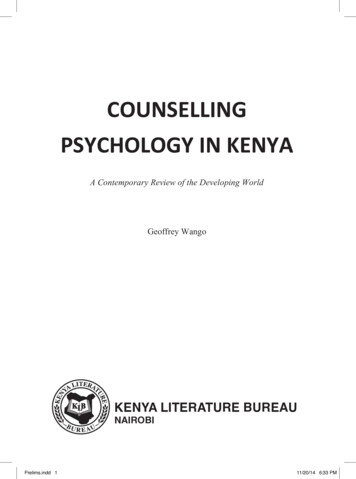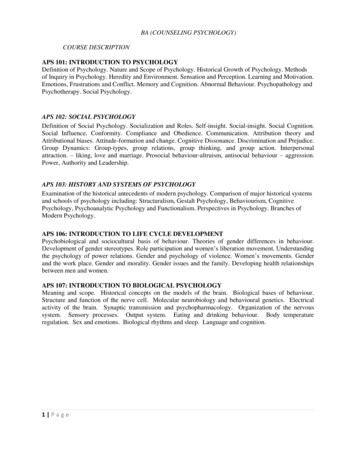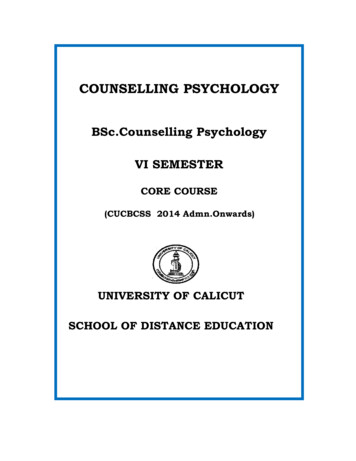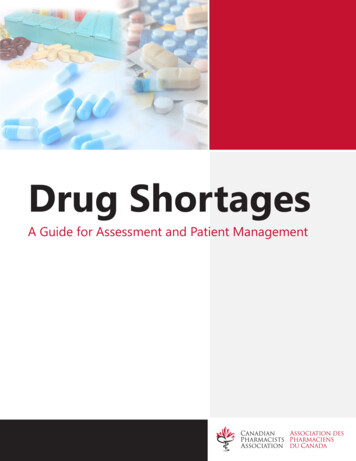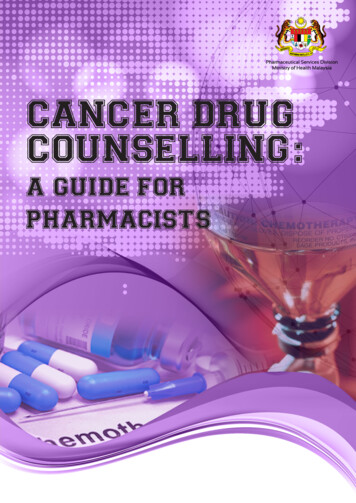
Transcription
CANCER DRUGCOUNSELLING :A GUIDE FORPHARMACISTS
CANCER DRUG COUNSELLINGA Guide for Pharmacists1st Edition, 2017Pharmaceutical Services DivisionMinistry of Health, MalaysiaPharmaceutical Services Division, Ministry of Health Malaysia1
DISCLAIMERThis guide would serve as a handy reference for PHARMACIST ONLY andnot as a complete drug information resource. It is NOT intended to replicateor replace the knowledge, skills and experience of trained oncology healthprofessionals, nor is it a substitute for clinical judgement and advice. Thenature of healthcare/drug information is that it is constantly evolving withongoing research and clinical experience and is often subject tointerpretation. While best effort has been made to ensure the accuracy of theinformation and recommendation presented, reader is advised that thecontributors, editors, reviewers and publishers cannot be responsible for thecontinued updates of the information, of any errors or/and of anyconsequences arising from its application.ALL RIGHTS RESERVEDThis is a publication of the Pharmaceutical Services Division, Ministry ofHealth Malaysia (MOH). Enquiries are to be directed to the address below.Permission is hereby granted to reproduce information contained hereinprovided that such reproduction be given due acknowledgement and shall notmodify the text.Pharmaceutical Services DivisionMinistry of Health MalaysiaLot 36, Jalan Universiti46350 Petaling JayaSelangor, MalaysiaTel: 603 - 7841 3200 Fax 603 - 7968 2222Website: www.pharmacy.gov.my2Pharmaceutical Services Division, Ministry of Health Malaysia
PREFACEProviding pharmaceutical care to patients througheducation and counselling can contribute towardsenhancing patients’ adherence to cancer drugtherapy as well as to reduce medication relatedproblems. The complexity of current cancer drugtherapies has resulted in changes in the role hospitalpharmacists play in their provision of care towardscancer patients today. It is an established fact thatprovision of the right information benefits patientsthrough shared decision making, and can lead to abetter quality of life, which is the aim of patient-oriented pharmaceuticalcare.The practice of hospital pharmacists may differ between facilities, butin general, oncology pharmacists are expected to be competent in both drugoriented services and patient centred care. The move towards daycare andoutpatient administration of chemotherapy has increased the necessity foraccurate and thorough patient and family education to enable them tomanage their medicines independently. This requires pharmacists to explainthe self-care activities to ensure proper use of their medications and to beaware of possible adverse effects and remedial choices to be taken in order tominimise risks to the patients.This Counselling Handbook serve as a quick reference for cancer drugtherapy counselling points and is also intended to guide pharmacists inproviding effective and accurate patient education regarding their cancertherapy. I would like to commend the Clinical Pharmacy Working Committee(Oncology Pharmacy Subspecialty) for their contributions and commitmentin the development of this handbook. It is hoped that this handbook will be auseful guide for pharmacists working in the area of oncology and will helpfurther improve the care of cancer patients in this country.Thank you.ABIDA HAQ BINTI SYED M. HAQDirector of Pharmacy Practice and Development DivisionMinistry of Health MalaysiaPharmaceutical Services Division, Ministry of Health Malaysia3
ADVISORAbida Haq Syed M. HaqDirector of Pharmacy Practice and DevelopmentEDITORSNoraini MohamadPharmaceutical Services Division, MOHNurul Adha OthmanPharmaceutical Services Division, MOHNoor Liyana YusupPharmaceutical Services Division, MOHCONTRIBUTORSRozita MohamadChan Huan KeatDang Chee CheanHassan Basri RamliHamiza AzizKamarun Neasa Begam Mohd KassimKo ChingTiongLee Pooi MunLew Yie LinLee Leong SheanLing Chun MingMonica Yam FuiChienMuhammad Shahariz Mohamad AdzibMunirah MuhamadNazif Salihin Ahmad ImranNorhayati Md IsaRaja Mohd Khairulanuar Raja IsmailSujayah SuthandiramTajunisah Mohamed EusoffWan Nazuha Wan Rusik4Institut Kanser Negara, PutrajayaHosp. Sultanah Bahiyah, Alor SetarHosp. MelakaHosp. Sultanah Bahiyah, Alor SetarHosp. PutrajayaInstitut Kanser Negara, PutrajayaHosp. Umum Sarawak, KuchingHosp. Raja Permaisuri Bainun, IpohHosp. Sultan Haji Ahmad Shah, TemerlohHosp. Wanita & Kanak-Kanak SabahHosp. Umum Sarawak, KuchingHosp. Wanita & Kanak-Kanak SabahHosp. Tuanku Ja’afar, SerembanHosp. Sultanah Zahirah, Kuala TerengganuHosp. Raja Perempuan Zainab II, Kota BharuHosp. Sultan Ismail, Johor BahruHosp. Raja Perempuan Zainab II, Kota BharuHosp. AmpangHosp. Pulau PinangHosp. Kuala LumpurPharmaceutical Services Division, Ministry of Health Malaysia
ACRONYMS & ABBREVIATIONSAPML: Acute promyelocyticleukemiaALP: Alkaline phosphataseALT: Alanine transaminaseAST: Aspartate aminotransferaseAUC: Area under the curveBD: (bis die) Twice dailyBUN: Blood urea nitrogenCHF: Congestive heart failureCNS: Central Nervous SystemCOPD: Chronic obstructivepulmonary diseaseCrCl: Creatinine clearanceDVT: Deep vein thrombosisD5W: Dextrose 5% in waterECG: ElectrocardiogramGI: GastrointestinalGutt: Eye dropGVHD: graft-versus-host diseaseHBsAg: Surface antigen ofHepatitis B VirusHBcAb: Hepatitis B core antibodyHSCT: Hematopoietic stem celltransplantIg G: Immunoglobulin GIM: IntramuscularINR: International normalised ratioIV: IntravenousIT: IntrathecalLVEF: Left ventricular ejectionfractionLFT: Liver function testMAOI: Monoamine oxidaseinhibitorMI: Myocardial infarctionNS: Normal salineNSAIDs: Non-steroidal antiinflammatory drugsOD: (omne in die) Once dailyPO: (Per os) By mouthRPLS: Reversible posteriorleukoencephalopathy syndromeSC: SubcutaneousSNRI: Serotonin andnorepinephrine reuptake inhibitorSOB: Shortness of breathSSRI: Selective serotonin reuptakeinhibitorULN: Upper limit of normalVTE: Venous thromboembolismWFI: Water for injection5FU: FluorouracilPharmaceutical Services Division, Ministry of Health Malaysia5
Table of ContentsContents6PageIntroduction9CHAPTER 1-INTRODUCING CHEMOTHERAPY TO PATIENTS10CHAPTER 2-DRUGS USED IN CANCER TREATMENT13Alemtuzumab - 30mg/ml Injection13All Trans Retinoic Acid (ATRA) - 10mg Capsule15Amsacrine - 75mg/1.5ml Injection17Anagrelide - 0.5mg, 1mg Capsule19Anastrozole - 1mg Tablet20Aprepitant - 125mg, 80mg Capsule21Arsenic Trioxide - 1mg/ml Injection22Azacitidine - 100mg Injection23Bevacizumab - 25mg/ml Injection24Bicalutamide - 50mg Tablet26Bleomycin - 15mg Injection27Bortezomib - 3.5mg Injection28Busulfan - 6mg/ml Injection; 2mg Tablet30Capecitabine - 150mg, 500mg Tablet32Carboplatin - 10mg/ml Injection33Carmustine - 100mg Injection34Cetuximab - 5mg/ml Injection35Chlorambucil - 2mg Tablet37Cisplatin - 1mg/ml Injection38Cladribine - 10mg/ml Injection40Clodronate - 800mg Tablet41Cyclophosphamide - 200mg, 1000mg Injection; 50mg Tablet43Cytarabine - 100mg/ml Injection44Dacarbazine - 100mg Injection46Dactinomycin - 0.5mg Injection47Daunorubicin HCl - 20mg Injection49Decitabine - 50mg Injection50Docetaxel - 40mg/ml Injection51Doxorubicin - (Pegylated Liposomal) 20mg Injection53Doxorubicin - 2mg/ml Injection55Epirubicin - 10mg, 50mg Injection57Pharmaceutical Services Division, Ministry of Health Malaysia
Erythropoietin Human Recombinant (Epoitin Alfa) - 2,000IU/0.5ml,3,000IU/0.3ml, 4,000IU/0.4ml, 10,000IU/ml InjectionErlotinib - 100mg, 150mg Tablet59Etoposide - 20mg/ml Injection; 50mg Capsule62Everolimus - 5mg, 10mg Tablet64Exemestane - 25mg Tablet66Fentanyl Transdermal Patch - 12mcg/hr, 25mcg/hr, 50mcg/hr67Filgrastim - 30MU/0.5ml, 30MU/ml Injection; PegFilgrastim Pre-filledSyringe 6mg/6ml InjectionFludarabine - 50mg Injection; 10mg Tablet69Fluorouracil - 50mg/ml Injection; 100mg Tablet71Flutamide - 250mg Tablet73Gabapentin - 100mg, 300mg, 600mg Tablet74Gefitinib - 250mg Tablet76Gemcitabine - 200mg, 1000mg Injection78Goserelin - 3.6mg, 10.8mg Depot Injection79Granisetron HCl - 1mg/ml Injection; 1mg Tablet80Hydroxyurea- 500mg Capsule81Idarubicin - 10mg, 5mg Injection82Ifosfamide - 1g Injection83Imatinib Mesylate - 100mg, 400mg Tablet85Interferon Alfa-2b - 18MiU, 30MiU Multidose Injection Pen87Irinotecan HCl Trihydrate - 20mg/ml Injection89Lapatinib - 250mg Tablet91L-asparaginase - 10,000IU Injection93Lenalidomide - 5mg, 10mg, 15mg, 25mg Capsule94Letrozole - 2.5mg Tablet95Leucovorin Calcium - 3mg, 50mg Injection, 15mg Tablet96Leuprolide - 11.25mg Injection97Lomustine - 40mg Tablet98Melphalan - 50mg Injection; 2mg Tablet99Mercaptopurine - 50mg Tablet100Mesna - 100mg/ml Injection101Methotrexate - 25mg/ml Injection; 2.5mg Tablet102Mitomycin C - 10mg Injection104Mitoxantrone - 2mg/ml Injection105Morphine Sulphate - Controlled Release: 10mg, 30mg Tablet / ImmediateRelease: 5mg, 10mg Tablet107Pharmaceutical Services Division, Ministry of Health Malaysia60707
Nilotinib - 200mg Tablet108Octreotide - 20mg, 30mg Injection110Ondansetron - 2mg/ml Injection; 2mg, 8mg Tablet112Oxaliplatin - 50mg Injection113Oxycodone HCl - Control Release: 10mg, 20mg, 40mg Capsule / ImmediateRelease: 5mg, 10mg, 20mg Capsule114Paclitaxel - 6mg/ml Injection116Palonosetron - 0.25mg/5ml Injection118Pamidronate - 30mg, 90mg Injection119Pazopanib HCl - 200mg, 400mg Tablet120Pemetrexed Disodium - 100mg, 500mg Injection122Procarbazine HCl - 50mg Capsule123Rituximab - 10mg/ml Injection125Sorafenib - 200mg Tablet126Sunitinib - 12.5mg, 25mg, 50mg Capsule128Tamoxifen Citrate - 20mg Tablet130Tegafur 100mg Uracil 224mg Capsule131Temozolomide - 20mg, 100mg Capsule132Thalidomide - 50mg Capsule133Thioguanine - 40mg Tablet134Trastuzumab - 440mg Injection135Vinblastine - 10mg Injection137Vincristine - 1mg Injection138Vindesine - 5mg/5ml Injection140Vinorelbine - 10mg, 50mg Injection141Zoledronic Acid - 4mg Injection143CHAPTER 3 - GUIDING PATIENTS TO MANAGE COMMON SIDE EFFECTS OF 144CANCER DRUGSMyelosuppresion144Gastrointestinal y149Dermatological Toxicities150Sexuality151APPENDIX: Oral Chemotherapy Administration Guide8152Pharmaceutical Services Division, Ministry of Health Malaysia
INTRODUCTIONPharmacists are tasked to educate and provide drug counselling topatients in order to improve their adherence with their complicated cancermedications. This guide is intended to serve as a quick reference forpharmacists who counsel cancer patients. It is designed to guide counsellingsystematically with the provided chapters:a) Chapter 1: Introducing Chemotherapy to PatientsA guide to patient need-to-know information about cancer treatmentin lay language. It gives a general overview about cancer treatmentincluding the definitions of commonly used medical terms, side effects,precautions and general counselling points for patients duringchemotherapy.b) Chapter 2: Drugs Used in Cancer TreatmentThis is the drug information section of this guide. All drugs are listedalphabetically by generic names. It provides a brief summary ofimportant drug counselling points, instructions to take medicine,storage and handling of products, precautions, interactions and sideeffects. This is NOT an exhaustive list of drugs used in cancer treatmentand is NOT a complete drug information resource. Reference to otherdrug literature is advised if further details are required.c) Chapter 3: Guiding Patients to Manage the Common SideEffects of Cancer DrugsThis chapter is dedicated to teaching patients about the common sideeffects of their pharmacotherapy which ranged from myelosuppressionto sexuality issue. It provides advice on prevention, self-monitoring,treatment and coping with the effects.Pharmaceutical Services Division, Ministry of Health Malaysia9
CHAPTER 1-INTRODUCING CHEMOTHERAPY TOPATIENTSGeneral Counselling Points for Patients During Chemotherapya) Avoid crowded areas.b) Wear protective mask.c) Go to the nearest hospital if there are signs of fever, prolonged bleedingor unexplained fatigue.d) Avoid smoking or alcohol consumption.e) Avoid uncooked food, eat a well-balanced diet and drink plenty of water.f) Get plenty of rest and sleep.g) Perform daily activities and exercise as tolerated.h) Consult doctor for choice of contraception measures. Discuss with doctorif plan to get pregnant.i) Discuss with the doctor or pharmacist before taking any onalorcomplementary medicines. Some may seriously interfere with thetreatment that has been prescribed.j) Discuss with the healthcare provider regarding side effects encounteredduring chemotherapy. Consult doctor if wish to stop therapy for anyreason.Counselling Patients About Their Oral ChemotherapyThe use of oral cancer drug has significantly increased during the pastyears and is anticipated to continue to grow. It has gained much popularityamong patients due to its convenience. Unfortunately, it is often wronglyperceived to be less toxic and more tolerable than conventionalchemotherapy. The shift of treatment responsibility from healthcare facilitiesinto patient’s home raises significant concern about medication safety.Therefore, effective counselling is vital to educate and empower patients toengage in their own medication management for a safe and optimaltreatment outcome.Patients and carer need to be well-informed about the treatment and beprovided with written guide for medication administration, importance ofearly recognition and prompt management of side effects. Emphasise on theimportance of adherence in order to achieve optimal outcome withoutcompromising patient safety.10Pharmaceutical Services Division, Ministry of Health Malaysia
In summary, the following points should be addressed during drugcounselling sessions:a) 5R: The right patient, medicines, dose, route and time of administration(in regards to food intake).b) The name and indications of their medications, including supportivemedications.c) Treatment schedule; when to start, stop and interval between doses aswell as duration of each cycle and total number of cycle.d) Common and significant side effects and the treatment managements.e) Steps to be taken in the event of fever or other signs of infection.f) Any drug or food interactions.g) The arrangements for resupply either from the hospital, health clinic orretail pharmacy; supply adequate quantity for each cycle only, advice toreturn any unused or extra medication.h) Storage instructions and emphasise on keeping out of children’sreach.i) Any handling or safety precautions; cytotoxic drugs should not behandled by pregnant women.j) “Do not cut/ crush / chew”k) Any issues on fertility.l) Clear advice if the patient misses a dose or vomits shortly after the doseis taken: Take the medication at the same time each day. If vomiting occurs within 1 hour of taking a dose, consult doctor orhealthcare providers. If missed a dose, take it as soon as possible and do not double thedose.- Once a day dosing : If it is more than 12 hours since misseddose, skip the missed dose and go back to usual dosing time.- Twice a day dosing : If it is more than 6 hours since misseddose, skip the missed dose and go back to usual dosing time.Pharmaceutical Services Division, Ministry of Health Malaysia11
General Precautions During Cancer Treatmenta) Check with doctor or pharmacist before start taking any new drugs(including over-the counter, nutritional supplements, vitamins, andherbal drugs). Discuss with doctor before receiving any immunisation.This is to prevent drug-induced immunosuppression.b) Inform doctor immediately if patient or partner becomes pregnant; maycause foetal harm.c) Breastfeeding is not encouraged during treatment as it may harm thebaby.d) Inform doctor or dentists if on chemotherapy.e) Avoid alcohol. It may interfere with the way some chemotherapy drugsworkReferences:1. Sam M. (2012) How to counsel cancer patients about their oral chemotherapy. Clinical Pharmacist, 4(1) 171.2. National patient Safety Agency (2008) Risks of incorrect dosing of oral anti-cancer medicines. Rapid ResponseReport. [Online] (1). Available from – www.nrls.npsa.nhs.uk/resources. [Accessed: 9th September 2015]12Pharmaceutical Services Division, Ministry of Health Malaysia
CHAPTER 2-DRUGS USED IN CANCER TREATMENTAlemtuzumab - 30mg/ml InjectionInstruction Route of administration: IV, SC. Premedication: IV chlorpheniramine, PO paracetamol 30 minutes prior toinfusion. IV: do not administer as IV push/bolus. SC: SC administration reduces infusion-related symptoms. Ice packsapplied to the injection site 15 minutes prior to and 15 minutes postinjection may decrease the severity of skin reactions. Cold compressesapplied for 15-20 minutes, several times a day after treatment may alsohelp to alleviate symptoms.Storage Store the concentrate at 2-8 C. Diluted solution store at room temperature or in refrigerator. Use within 8hours. Protect from light.Precaution Single dose of alemtuzumab greater than 30 mg or cumulative dosesgreater than 90 mg per week increase the incidence of pancytopenia. Use with caution in patients with recent exposure to chicken-pox virus. Use with caution in patients with previous hypersensitivity reaction toother monoclonal antibodies. Transfusion related GVHD: eliminate risk by using irradiated bloodproducts. Pregnancy Risk Factor : C Adequate contraception should be used by both sexes while on therapy andfor 6 months following discontinuation of therapy Discontinue breastfeeding during treatment and for at least 3 monthsfollowing the last dose of alemtuzumab as human Ig G is excreted in breastmilk.Drug-Disease Interaction Hepatitis B reactivation: Test for HBsAg and HBcAb. If positive, treat withLamivudine 100 mg/day orally, for the entire duration of chemotherapy andfor six months afterwards.Drug-Herb Interaction Echinacea: May diminish therapeutic effect of alemtuzumab.Pharmaceutical Services Division, Ministry of Health Malaysia13
Side Effects Haematologic toxicities (lymphopenia, neutropenia, thrombocytopenia). Infusion related reaction (fever, rigors, hypotension, SOB, rash). Infection: High risk of opportunistic bacterial or viral infections.Administer prophylactic medication against PCP and herpes viralinfection. GI toxicities (nausea & vomiting, diarrhoea). Pulmonary toxicities (dyspnoea, cough). Incidences of side effects are less with SC use.References:1. Drug information handbook. 24th edition. Lexicomp.2. Bragalone DL. (eds.) Drug information handbook for oncology. 13th edition. Lexicomp.14Pharmaceutical Services Division, Ministry of Health Malaysia
All Trans Retinoic Acid (ATRA) - 10mg CapsuleInstruction Route of administration: PO Take with food and a glass of water or juice.Storage Store in a refrigerator and protect from light.Precaution May influence activities requiring alertness or coordination (such asdriving) due to its central nervous system side effects. Pregnancy Risk Factor: D Adequate contraception (2 reliable birth control) should be used while ontherapy and for 1 month following discontinuation of therapy.Drug-Disease Interaction Venous thrombosis, arterial thrombosis. Risk during first month oftherapy. May involve any organ system. Hypercholesterolaemia, hypertriglyceridemia (reversible upon completionof treatment).Drug-Drug Interaction Vitamin A: May increase ATRA toxicity (symptom of hypervitaminosis Asuch as dry mouth, rash, nausea and vomiting). Antifibrinolytic agents: May increase thrombogenic effect. Tetracycline derivatives: May increase pseudotumour cerebri (also knownas intracranial hypertension: symptoms include severe headache, nauseaand vomiting, visual changes) . Contraceptives pills (progesterone): May decrease effect of contraceptivespills.Drug-Herb St John's Wort: May decrease ATRA effect. Dong quai, St John's Wort: May increase photosensitisation.Pharmaceutical Services Division, Ministry of Health Malaysia15
Side Effects Haematologic toxicity (APML differentiation syndrome characterised byfever, dyspnoea, acute respiratory distress, weight gain, radiographicpulmonary infiltrates, pleural or pericardial effusions, oedema, hepatic,renal, and/or multiorgan failure). May need temporary interruption oftherapy. Skin toxicities (mucosal and skin dryness, rash). Cardiotoxicities (oedema, peripheral oedema, flushing). GI toxicities (minimal to low: nausea and vomiting, mucositis, constipation,diarrhoea, dry lips and mouth). CNS toxicity (headache). Occurs several hours after ATRA ingestion. Maydevelop tolerance with continued therapy. Renal toxicity (increased serum creatinine). Ocular toxicity (visual disturbances, photophobia). Ototoxicity (otalgia). General (weight gain, fatigue, fever).References:1. Drug information handbook. 24th edition. Lexicomp.16Pharmaceutical Services Division, Ministry of Health Malaysia
Amsacrine - 75mg/1.5ml InjectionInstruction Route of administration: IV Do not administer IT, IM or SC Compatible with D5W only. Precipitation will occur in the presence ofchloride or sulphate ions.Storage Store at room temperature. Protect from light. Concentrated amsacrine should not remain in plastic syringe for more than15 minutes.Precaution Use with caution in renal and hepatic impairment. May need dosemodification. Pregnancy Risk Factor: Clinical data not available. Women of childbearingpotential should avoid becoming pregnant while receiving treatment. Extravasation injury: May cause severe tissue necrosis. Inform doctorimmediately when extravasation occurs.Drug-Disease Interaction Cardiac disease: May increase cardiotoxicity. Hypokalaemia: May increase risk of arrhythmia.Drug-Herb Interaction Echinacea: May decrease effects of amsacrine.Pharmaceutical Services Division, Ministry of Health Malaysia17
Side Effects nia,thrombocytopenia). GI toxicities (mucositis, low: nausea & vomiting, diarrhoea, perirectalabscess). Cardiotoxicities (arrhythmia, cardiomyopathy). CNS toxicities (seizures or loss of consciousness, headache, dizziness). Skin toxicities (alopecia, rash, urticaria). Renal toxicities (renal failure, urine discolouration: orange-red). Hepatotoxicities (hepatic insufficiency, hepatitis). Vascular toxicity (phlebitis: concentration related - reduced by infusingover at least 60 min).References:1. Drug information handbook. 24th edition. Lexicomp.2. Bragalone DL. (eds.) Drug information handbook for oncology. 13th edition. Lexicomp.3. Loughran C. (2014) Macmillan Cancer Support [Online] Available from drugs/Amsacrine.aspx. [Accessed: 9th September 2015]4. Allwood M., Stanley A., Wright P. (eds.)(1997) The cytotoxics handbook. 3rd edition. Washington DC: AmericanPharmaceutical Association.18Pharmaceutical Services Division, Ministry of Health Malaysia
Anagrelide - 0.5mg, 1mg CapsuleInstruction Route of administration: PO Take with food (if it causes stomach upset) or on an empty stomach.Storage Store at room temperature and protect from light.Precaution Use with caution in hepatic impairment. May need dose modification. May cause sterility in men. Discuss with doctor if plan to have children. Pregnancy Risk Factor: CDrug-Disease Interaction Cardiac Disease: May increase heart rate.Drug-Drug Interaction Aspirin, NSAIDs (especially non-selective), anticoagulants: May increaserisk of bleeding. Sucralfate: May decrease anagrelide effect.Drug-Food/Herb Interaction Glucosamine, omega-3, alfalfa, anise, bilberry, bromelain, cat's claw,celery, chamomile, cordyceps, dong quai, evening primrose oil, fenugreek,feverfew, garlic, ginger, ginkgo biloba, ginseng, grape seed, green tea, horsechestnut seed, liquorice, red clover, reishi, sweet clover, turmeric, whitewillow: may increase risk of bleeding.Side Effects Haematologic toxicities (thrombocytopenia, anaemia). Cardiotoxicities (peripheral oedema, tachycardia, angina, arrhythmia,heart failure, hypertension, postural hypotension, syncope, thrombosis,vasodilatation). CNS toxicities (dizziness, amnesia, confusion, depression, insomnia,migraine, nervousness, somnolence). GI toxicities (low: nausea & vomiting, diarrhoea, abdominal pain). Skin toxicities (photosensitivity, pruritus, alopecia, urticaria). Flu like symptoms (fever, fatigue, chills, headache, arthralgia).References:1. Drug information handbook. 24th edition. Lexicomp.2. Bragalone DL. (eds.) Drug information handbook for oncology. 13th edition. Lexicomp.Pharmaceutical Services Division, Ministry of Health Malaysia19
Anastrozole - 1mg TabletInstruction Route of administration: PO Take with food or on an empty stomach with a glass of water or juice.Storage Store at room temperature. Protect from light, heat and moisture.Precaution Should not be administered to women with pre-menopausal endocrinestatus. Pregnancy Risk Factor: X May decrease bone mineral density. Monitor bone density.Drug-Drug Interaction Oestrogen-containing therapies: May interfere with therapeutic effect ofanastrazole.Side Effects Endocrine (hot flushes: take tablet at bedtime). Musculoskeletal (arthralgia, myalgia, headache, back pain, risk offracture). Cardiotoxicities (increased incidence of ischaemic events in women withpre-existing ischaemic heart disease, peripheral oedema). GI toxicity (nausea: take the tablet right after a meal). General (may elevate the cholesterol level, fatigue, weight gain). Sexual / reproductive dysfunction (vaginal dryness).References:1. Drug information handbook. 24th edition. Lexicomp.2. Bragalone DL. (eds.) Drug information handbook for oncology. 13th edition. Lexicomp.20Pharmaceutical Services Division, Ministry of Health Malaysia
Aprepitant - 125mg, 80mg CapsuleInstruction Route of administration: PO Patient should receive a package containing 3 capsules of aprepitant. It istaken as 3 doses over 3 days. Day 1: Take one 125mg capsule by mouth 1 hour prior to chemotherapy. Day 2 and Day 3: Take one 80mg capsule by mouth, each morning for 2days. Take with food or on an empty stomach with a glass of water.Storage Store at room temperature.Precaution Pregnancy Risk Factor: B Avoid pregnancy while on therapy and for 1 month followingdiscontinuation of therapy.Drug-Drug Interaction Cisapride, pimozide, terfenadine and astemizole: May cause lifethreatening interactions. May decrease the effectiveness of warfarin, phenytoin and oralcontraceptives via induction of their metabolism.Drug-Herb Interaction St John's Wort : May decrease aprepitant level.Side Effects CNS toxicities (headache, fatigue). GI toxicities (nausea, diarrhoea, constipation). Pulmonary toxicity (hiccups).References:1. Drug information handbook. 24th edition. Lexicomp.2. Bragalone DL. (eds.) Drug information handbook for oncology. 13th edition. Lexicomp.3. Electronic Medical Compendium. (2015) [Online] Available from http://www.medicines.org.uk/emc/medicine/13868. [Accessed: 9th September 2015]Pharmaceutical Services Division, Ministry of Health Malaysia21
Arsenic Trioxide - 1mg/ml InjectionInstruction Route of administration: IV Infuse over 1-2 hours. May be extended up to 4 hours if vasomotor reactionsare observed.Storage Store at room temperature.Precaution Administer drug in a controlled setting with careful monitoring of bloodpressure & ECG. Correct hypokalaemia and hypomagnesaemia if present, before initiationof the treatment. Use with caution in heart failure, history of torsade de pointes, long QTsyndrome and/ or on other medications that prolong the QT interval. Use with caution in renal impairment (CrCl 30ml/min). May need dosemodification. Pregnancy Risk Factor : D Avoid pregnancy while on therapy and for at least 3 months followingdiscontinuation of therapy. Breastfeeding is not recommended during therapy and for 3 monthsfollowing discontinuation of therapy.Drug-Drug Interaction Clozapine, ivabradine and mifepristone: May increase risk of QTcprolongation. Avoid concomitant use.Side Effects Abnormal heart rhythm (QT prolongation). Metabolism and nutrition disorders (hypokalaemia, hypomagnesaemia,hyperglycaemia). APML differentiation syndrome (e.g. dyspnoea, chest pain, cough, fever,oedema). Haematologic toxicities: Hyperleukocytosis (leukocytes 10,000m3),anaemia, thrombocytopenia. Fatigue. Infection. GI toxicities (diarrhoea, low to moderate: nausea).References:1. Drug information handbook. 24th edition. Lexicomp.2. Bragalone DL. (eds.) Drug information handbook for oncology. 13th edition. Lexicomp.3. Electronic Medical Compendium. (2015) [Online] Available from http://www.medicines.org.uk/emc/medicine/28860. [Accessed: 9th September 2015]22Pharmaceutical Services Division, Ministry of Health Malaysia
Azacitidine - 100mg InjectionInstruction Route of administration: IV, SC IV: infuse over 10 - 40 minutes. Incompatible with D5W. SC: Do not filter after reconstitution. Resuspend contents of syringe byvigorously rolling between palms immediately prior to administration. Use air-sandwich technique to minimise risk and severity of injection sitereaction. Administer at the upper arm, thigh or abdomen. Doses more than 4mlshould be injected into two separate sites. Injection sites should be rotated.New injections should be given at least 2.5cm apart from the previous site.Storage Store at room temperature.Precaution Contraindicated in advance malignant hepatic tumours. Pregnancy Risk Factor: D Women of child-bearing potential should continue birth control up to 3months and men up to 6 months following discontinuation of therapy.Side Effects Haematologic toxicities (thrombocytopenia, anaemia, neutropenia). GI toxicities (constipation, low to moderate: nausea and vomiting). Fatigue. Pulmonary toxicity (dyspnoea). Injection site reaction (bruising, erythema, pain). CNS to
Pharmacists are tasked to educate and provide drug counselling to patients in order to improve their adherence with their complicated cancer medications. This guide is intended to serve as a quick reference for pharmacists who counsel cancer patients. It is designed to guide

